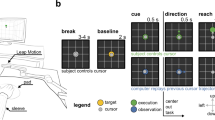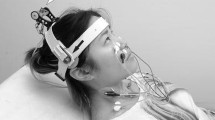Abstract
It is well known that during volitional sinusoidal tracking the long-latency reflex modulates in parallel with the volitional EMG activity. In this study, a series of experiments are reported demonstrating several conditions in which an uncoupling of reflex from volitional activity occurs. The paradigm consists of a visually guided task in which the subject tracked a sinusoid with the wrist. The movement was perturbed by constant torque or controlled velocity perturbations at 45° intervals of the tracking phase. Volitional and reflex-evoked EMG and wrist displacement as functions of the tracking phase were recorded. The relationship of both short-latency (30–60 ms) and longer-latency (60–100 ms) reflex components to the volitional EMG was evaluated. In reflex tracking, the peak reflex amplitude occurs at phases of tracking which correspond to a maximum of wrist joint angular velocity in the direction of homonymous muscle shortening and a minimum of wrist compliance. Uncoupling of the reflex and volitional EMG was observed in three situations. First, during passive movement of the wrist through the sinusoidal tracking cycle perturbation-evoked long-latency stretch reflex peak is modulated as for normal, volitional tracking. However, with passive joint movement the volitional EMG modulation is undetectable. Second, a subset of subjects demonstrate a normally modulated and positioned long-latency reflex with a single peak. However, these subjects have distinct bimodal peaks of volitional EMG. Third, the imposition of an anti-elastic load (positive position feedback) shifts the volitional EMG envelope by as much as 180° along the tracking phase when compared with conventional elastic loading. Yet the long-latency reflex peak remains at its usual phase in the tracking cycle, corresponding to the maximal velocity in the direction of muscle shortening. Furthermore, comparison of the results from elastic and anti-elastic loads reveals a dissociation of short- and long-latency reflex activity, with the short-latency reflex shifting with the volitional EMG envelope. Comparable results were also obtained for controlled velocity perturbations used to control for changes in joint compliance. The uncoupling of the reflex and volitional EMG activity in the present series of experiments points to a flexible relationship between reflex and volitional control systems, altered by peripheral input and external load.
Similar content being viewed by others
References
Akazawa K, Milner TE, Stein RB (1983) Modulation of reflex EMG and stiffness in response to stretch of human finger muscle. J Neurophysiol 49:16–27
Aniss AM, Gandevia SC, Burke D (1988) Reflex changes in muscle spindle discharge during a voluntary contraction. J Neurophysiol 59:908–920
Bedingham W, Tatton WG (1984) Dependence of the EMG responses evoked by imposed wrist displacements on pre-existing activity in the stretched muscles. Can J Neurol Sci 11:272–280
Burke D, McKeon B, Westerman RA (1980) Induced changes in the thresholds for voluntary activation of human spindle endings. J Physiol 302:171–181
Calancie B, Bawa P (1985) Firing patterns of human flexor carpi radialis motor units during the stretch reflex. J Neurophysiol 53:1179–1193
Capaday C, Stein RB (1987) Difference in the amplitude of the human soleus H-reflex during walking and running. J Physiol 392:513–522
Cody FWJ, Macdermott N, Matthews PBC, Richardson HC (1986) Observations on the genesis of the stretch reflex in Parkinson's disease. Brain 109:229–249
Dufresne JR, Soechting JF, Terzuolo CA (1980) Modulation of the myotatic reflex gain in man during intentional movements. Brain Res 193:67–84
Dufresne JR, Gurfinkel VS, Soechting JF, Terzuolo CA (1978) Response to transient disturbances during intentional forearm flexion in man. Brain Res 150:103–115
Gielen CCAM, Houk JC (1984) Nonlinear viscosity of the human wrist. J Neurophysiol 52:553–569
Gottlieb GL, Agarwal GC (1973) Modulation of postural reflexes by voluntary movement I. Modulation of the active limb. J Neurol Neurosurg Psychiatry 36:529–539
Gottlieb GL, Agarwal GC (1988) Compliance of single joints: elastic and plastic characteristics. J Neurophysiol 59:937–951
Hagbarth KE, Wallin G, Lofstedt L (1975) Muscle spindle activity in man during voluntary fast alternating movements. J Neurol Neurosurg Psychiatry 38:625–635
Hick WE (1952) On the rate of gain of information. Q J Exp Psychol 4:11
Hogan N (1984) Adaptive control of mechanical impedance by coactivation of antagonist muscles. IEEE Trans Auto Control AC-29:681–690
Houk JC (1979) Regulation of stiffness by skeletomotor reflexes. Ann Rev Physiol 41:99–114
Hulliger M, Vallbo AB (1979) The responses of muscle spindle afferents during voluntary tracking movements in man. Load dependent servo assistance? Brain Res 166:401–404
Jaeger RJ, Gottlieb GL, Agarwal GC (1982) Myoelectric responses at flexors and extensors of human wrist to step torque perturbations. J Neurophysiol 48:388–402
Johnson M, Kipnis A, Ebner T (1991) Independence of reflex and volitional EmG modulation during sinusoidal tracking in normals. Soc Neurosci Abstr 19:1028
Johnson MTV, Kipnis AN, Lee MC, Loewenson RB, Ebner TJ (1991) Modulation of the stretch reflex during volitional sinusoidal tracking in Parkinson's disease. Brain 114:443–460
Kearney RE, Hunter IW (1990) System identification of human joint dynamics. CRC Crit Rev Biomed Eng 18:55–87
Kirsch RF, Rymer WZ (1987) Neural compensation for muscular fatigue: evidence for significant force regulation in man. J Neurophysiol 57:1893–1910
Liddell EGT, Sherrington CS (1924) Reflexes in response to stretch (myotatic reflexes). Proc R Soc Lond [Biol] 96:212–242
MacKay WA, Kwan HC, Murphy JT, Wong YC (1983) Stretch reflex modulation during a cyclic elbow movement. Electroenceph Clin Neurophysiol 55:687–698
Marsden CD, Merton PA, Morton HB (1972) Servo action in human voluntary movement. Nature 238:140–143
Marsden CD, Merton PA, Morton HB (1976) Servo action in the human thumb. J Physiol 257:1–44
Marsden CD, Merton PA, Morton HB (1977) The sensory mechanism of servo action in human muscle. J Physiol 265:521–535
Matthews PBC (1986) Observations on the automatic compensation of reflex gain on varying the pre-existing level of motor discharge in man. J Physiol 374:73–90
Ribot E, Roll J, Vedel J (1986) Efferent discharges recorded from single skeletomotor and fusimotor fibers in man. J Physiol 375:251–268
Romano C, Schieppati M (1987) Reflex excitability of human soleus motoneurons during voluntary shortening or lengthening contractions. J Physiol 390:271–284
Rothwell JC, Obeso JA, Traub MM, Marsden CD (1983) The behaviour of the long-latency stretch reflex in patients with Parkinson's disease. J Neurol Neurosurg Psychiatry 46:35–44
Soechting JF, Dufresne JR, Laquaniti F (1981) Time-varying properties of myotatic response in man during some simple motor tasks. J Neurophysiol 46:1226–1243
Stein RB (1974) Peripheral control of movement. Physiol Rev 54:215–337
Tatton WG, Lee RG (1975) Evidence for abnormal long-loop reflexes in rigid Parkinsonian patients. Brain Res 100:671–676
Weiss PL, Kearney RE, Hunter IW (1986) Position dependence of ankle joint dynamics. I. Passive mechanics. J Biomech 19:727–735
Author information
Authors and Affiliations
Rights and permissions
About this article
Cite this article
Johnson, M.T.V., Kipnis, A.N., Lee, M.C. et al. Independent control of reflex and volitional EMG modulation during sinusoidal pursuit tracking in humans. Exp Brain Res 96, 347–362 (1993). https://doi.org/10.1007/BF00227114
Received:
Accepted:
Issue Date:
DOI: https://doi.org/10.1007/BF00227114




